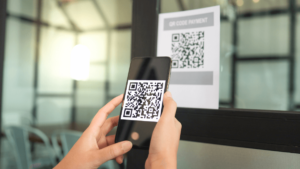The theft of office supplies might seem like a minor issue you can ignore, but it costs businesses a lot more than it appears at first glance.
People who decide to steal at work often keep doing it for years until their employer catches them.
Therefore, if you want to prevent theft, you need to understand why employees steal and what they steal the most.
With this knowledge in mind, you can follow the eight tips in this article to ensure you’re doing everything you can to discourage the theft of office supplies.
In this article...
Why Are People Stealing Office Supplies
An important thing to understand is the motivation behind the theft of office supplies. When you know the reasoning, you can work on prevention from that angle.
It might surprise you that 75% of employees admit to stealing from their company at least once, so it’s crucial to understand their motives.
Most office supplies thefts are unrelated to kleptomania. While some employees steal because of financial gain, the most common fuel for office supplies theft is much simpler—dissatisfaction.
Such feelings can arise if employees feel let down by management.
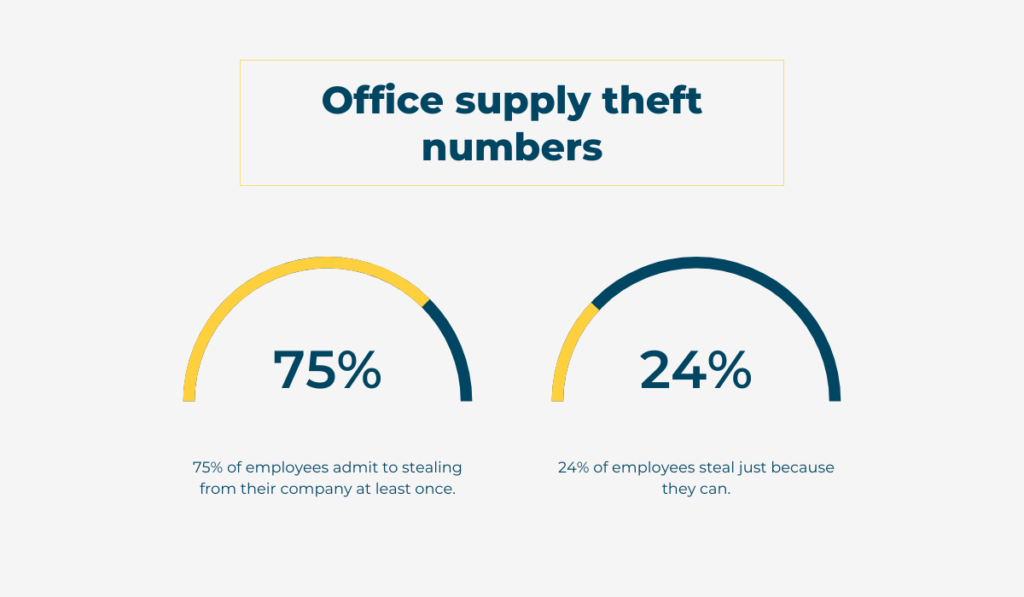
Employees join a company with a set of commitments and expectations not explicitly stated in the contract, ranging from a supportive and friendly workplace to an acceptable workload.
This is often referred to as the psychological contract.
However, not all employers deliver on those promises or live up to expectations, leaving workers feeling wronged.
If they think they can’t change their circumstances, employees often feel stuck.
In those circumstances, to get revenge on the company, they decide to take a thing or two from the workplace as a sign of silent protest.
The problem is that this single act like that can become a habit.
Also, when an employee sees others stealing and getting away with it, they are more likely to do the same thing to feel like they belong, especially if they’re also unhappy with the working conditions.
An additional 24% of employees don’t steal because they need the items or hold a grudge—they steal because they can.
They feel that a company that has more than one of the same type of item won’t miss it.
What Office Equipment Gets Stolen the Most
It’s important to note that, when your employees want to steal from you, they are not trying to get fired.
Their goal is not to cause substantial financial loss to the company—it’s to get back at you without anyone finding out.
Because of this, most workplace thieves limit themselves to smaller pieces of inventory such as stationery and copier papers.
They believe that nobody will notice that such small items are gone, allowing them to derive satisfaction from the act without fear of repercussions.
The stationery items that get stolen most include post-its and paper clips, tools like scissors and staplers, and different writing utensils.
Copier papers and printer ink are also on that list.
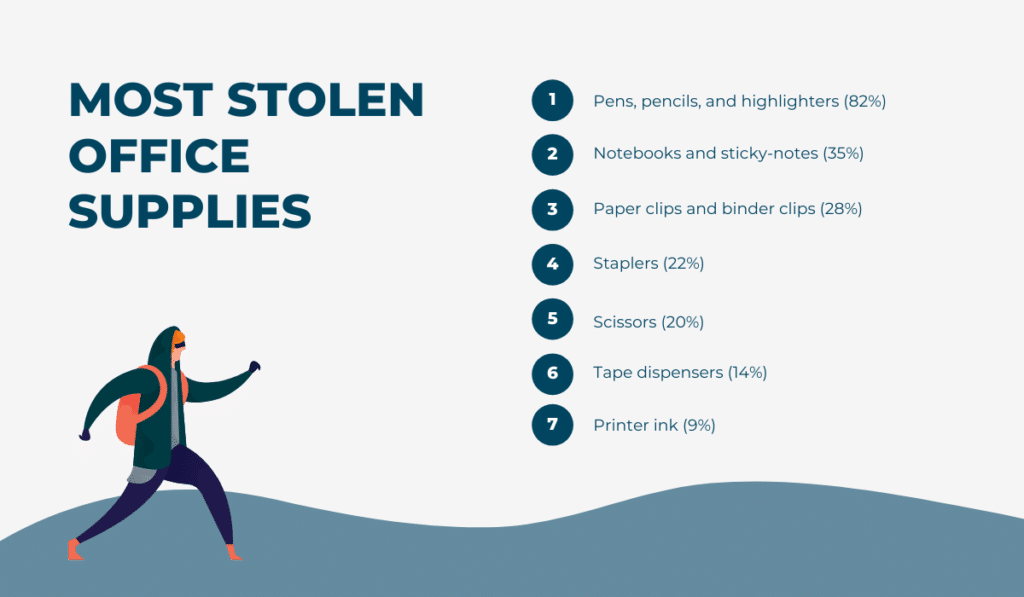
While all this equipment seems irrelevant, continuous stocking-up is not cheap, especially if many employees steal from you.
Over time, the costs can rack up to millions—just ask the management of the Austin Library, which lost $1.3 million in toner cartridges that an employee stole and resold online.
Some employees, therefore, have an ulterior motive that goes deeper than dissatisfaction with the treatment they get at work.
Of course, not all workplace thefts are related to inexpensive inventory.
Some employees decide to steal bigger pieces of equipment, such as company-provided smartphones, laptops, and other digital equipment.
Each of these can cost a lot to replace, so it’s time you put a stop to thefts, no matter how insignificant.
How to Prevent Office Supply Theft
Since even the smallest thefts can end up costing you a lot, you should find effective ways to prevent it from happening.
Here are eight steps you can take to ensure your equipment stays in the office.
Take Note of Employee Satisfaction
If you value employee satisfaction, you can prevent workplace theft.
As mentioned earlier in this post, the number one cause of office supply theft is employee dissatisfaction, which is why it’s important to understand how happy your employees are.
Your employees might feel that you’re underdelivering on your promises and mistreating them. Not many of them will confront you about this issue.
Instead, they’ll turn to small thefts to get back at you.
If committed by as many employees as surveys show, such thefts can rack up unexpected costs and negatively affect all other employees.
To prevent this, you should make employee satisfaction a priority. Find a way to measure it, preferably anonymously, as this will show you how your team members really feel.
Once you survey your team, you can draw conclusions about the general satisfaction at the workplace and points where they feel you are lacking.
If you notice that many employees feel overworked, it might be time to reevaluate your task management practices and either allocate tasks better or hire more people.
Whatever you choose to improve, include your employees in the process to make them feel heard and appreciated.
Explain that you are making these changes based on the feedback you’ve received from them.
When you take your employees’ satisfaction into account, you can minimize the occurrence of office supply theft.
Manage Your Inventory Better
To start understanding what office supplies are disappearing, you need to have a clear understanding of what you even own.
On paper, you might have a lot more inventory than you do.
Office supplies are mostly expendable things like pens, notepads, and post-its, meaning that you won’t have them forever. They can also get damaged or break.
However, if you’re losing more office supplies than you thought you would, you might have a theft problem.
Begin with making a list of everything you have. It might take a while, it can be tedious, but you’ll never understand what exactly is disappearing without completing this step.
Suppose you don’t have the time or energy to create an inventory list on paper and update it manually every once in a while.
You should then opt for software that lets you create an equipment database. Such a list is easier to update and check since you can pull up asset information in a couple of clicks.
Here’s an example of a list of equipment in GoCodes Asset Tracking app:

The database will serve as proof of the actual inventory you own at any given time.
You should update the list whenever there is an inventory change to ensure you’re always on top of the stock, allowing you to understand when you’re running low on supplies.
Creating an inventory list helps you understand what you have, allowing you to notice office theft.
Monitor Purchases
A good solution for workplace theft is monitoring your purchases.
Your inventory list will come in handy in this case as you will always tell how many office supplies you have.
You will see the history of such items, which will allow you to notice if you order specific items more frequently than expected. Also, you will understand what you need.
For example, if one of your employees keeps stealing copier paper, you will notice that you order a lot more of it than you spend.
What you can do to prevent this is to set up a system that will allow employees to request a purchase individually.
It will be easier for you to understand which employees make more orders than others, and whether you should investigate it.
At the same time, it will serve as a deterrent for people who intend to steal—they will understand that their name is associated with the purchase request and that you can notice if they order a lot more than they need.
Keeping an eye on your purchases helps you figure out what purchase requests are justified and who orders more than they need.
Introduce a Check-in/Check-Out System
A system that requires employees to check equipment in and out decreases the risk of office supply theft.
Once you have set up an inventory list and started to monitor purchases, consider implementing a check-in/check-out system for more valuable equipment such as IT supplies.
When an employee wants to check out an expensive piece of equipment, they need to record it in the system.
You can use a pen and paper for this, but such reports can be easily damaged or misplaced.
If you opt for software that lets you check equipment in and out, anyone can easily log in and mark the equipment as in use. With GoCodes Asset Tracking, you can easily oversee your check-in and checkout logs.
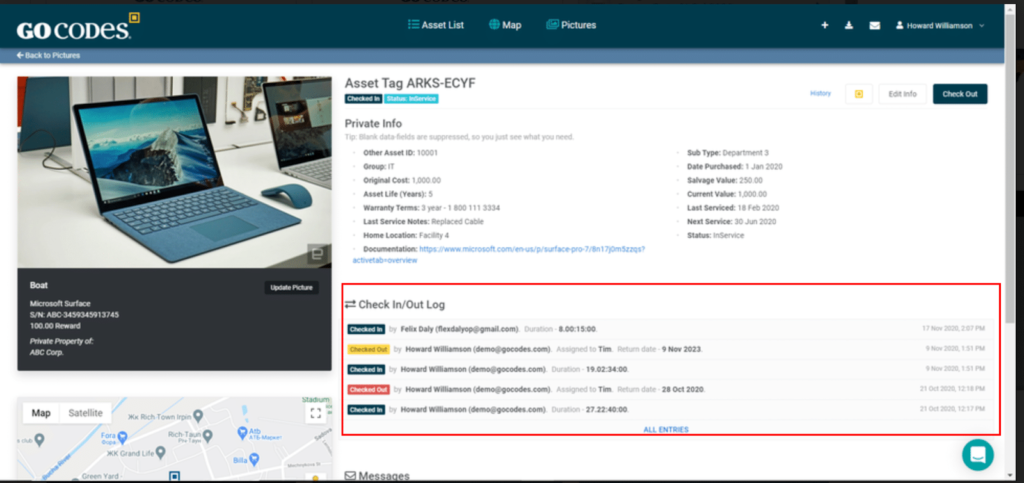
That way, the piece is directly associated with the employee.
Such systems promote personal responsibility and ensure that employees return the equipment.
After all, anyone who uses the system or checks the list will see who was the last person to use it.
If you use pen and paper, you will have to go through the file manually to find when the employee checked it out, which can be an issue if the record dates back to weeks or months ago.
The software can let you find this information by looking for the item using its name or code you’ve given it.
Even if the check-out date was months ago, you’ll still be able to see it in the asset’s history.
Also, tools like GoCodes Asset Tracking allow you to set up notifications that let you know when someone is late with returning equipment.
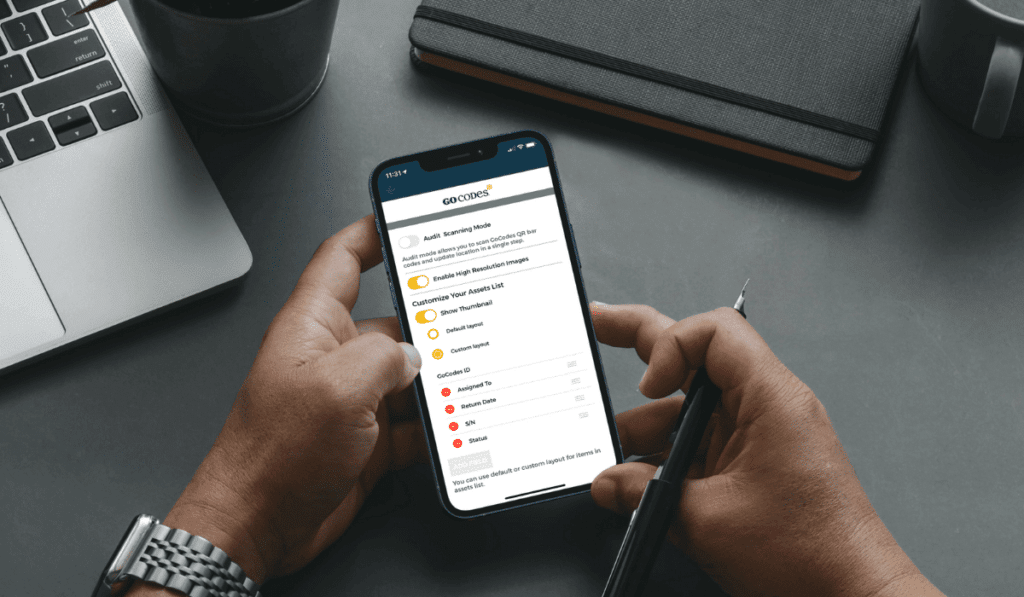
You or an administrator can contact the employee to understand the issue right away, instead of waiting for months for someone to notice the expensive office supply isn’t there.
Even though expendable items like pens and post-its aren’t expensive, it would be a good idea to have a check-out system in place—it would help you spot if someone keeps taking a lot more supplies than they can realistically spend.
Check-in/check-out system for your valuable assets prevents employees from quickly taking them home.
Keep Supplies Under Lock
Prevent theft by keeping your office supplies locked.
No matter where you store your office supplies, you’re bound to lose some if anyone can access them. Restricting access to inventory decreases the risk of theft, tampering, or misplacement as not all employees will be able to take whatever they want whenever they want it.
It would be wise to store your stock in the same room or area.
If your office supplies are scattered around the office, it is challenging to understand where each asset is and who took it.
If you decide to store all the inventory in a storage room, make sure to lock it. The people who need to use it should report what they need and get the key afterward.
Otherwise, you have no way of knowing who has used the room and what for.
The key needs to be with you, an executive, or storage room manager—in any case, a person in charge of stock who can check what the employee removed from the room.
That way, they can notice any discrepancies between what the person reported and what they actually took.
Once the employee takes the supplies they need, they should use the check-in/check-out system to report what they took and return the key to the person in charge.
That person can use the inventory data and compare it with the state of the room once the employee leaves.
Knowing that the equipment is locked and that they can access equipment only after asking for the key will deter employees from stealing—the risk of getting caught is significantly higher than if the supplies were just lying around.
Locking your supplies decreases the risk of theft since employees have to ask for the key to take anything from the room.
Create Clear Anti-Theft Policies
Make your anti-theft stance clear to your employees in order to prevent theft.
That’s why it’s a good idea to define clear, concise, and understandable anti-theft policies from the very beginning.
You should explain the policies to every new hire, give them handouts, and remind employees of them during refreshment training or meetings.
Such reminders are necessary because new hires are equally likely to steal as those who have been with the company for a while.
Your policies should define what the company regards as theft—even taking something as small as a pen still means that the employee is misappropriating company property, and they should be aware of it.
The policies should also make it clear what the company is doing to protect itself and other employees from theft.
As a business, you have every right to protect the assets you invest in, so you should explain the steps you’re taking to do that.
Sometimes, employees believe that executives are too busy to watch out for office supplies when they have bigger fish to fry, so this is a way to show them that’s not the case with you.
Furthermore, the policy should explain the consequences for anyone who steals.
Having a reminder that a pack of post-its can cost them their job or have some other undesirable consequences will surely discourage some employees from stealing.
Creating and explaining your anti-theft policies discourages employees from taking company property unauthorized.
Find Security Weaknesses
Taking the time to find your security weaknesses helps you eliminate them, thus preventing theft.
With your anti-theft policies, inventory management, and an effective check-in and check-out system, you should be all set to practically eradicate theft.
However, if you want to be entirely sure you’re doing everything you can to prevent employees from stealing office supplies, consider reviewing security practices.
The review will help you determine the weaknesses of your security system, and once you know what they are, you can remove them.
For instance, leaving important documents or assets on desks is an example of one such security risk.
Therefore, if you instruct your employees to return equipment after they no longer need it, store important documents in a safe place, or put all their office supplies in their desk drawers when their shift is over, you can help them protect your property.
Whoever wants to steal equipment will have a more challenging time locating it.
After all, grabbing something off of someone’s desk is a lot easier than shuffling through their drawers to find the asset.
Look for your office’s vulnerabilities, go through your current practices, and review them to understand what you can improve for maximum protection with minimal risks.
When you know where your security is lacking, you can improve to decrease the risk of theft.
Install Cameras
Using cameras to monitor your assets can help you stop employees from stealing office supplies.
A quality surveillance system is expensive, but so is stealing—employee theft costs US businesses up to $80 billion a year.
Even if your office doesn’t have costly equipment, you can lose a lot of money when your employees keep stealing from you.
A staggeringly high number of employees steal from their employer, and some of them do it for years before getting caught.
During those years, each employee that steals from you can lose you a lot more money than intended.
If you’re worried about the high costs of employee theft in your office, consider installing cameras to monitor your valuable equipment.
If you keep all the assets in the same storage room, you can have cameras only in that room to save up, but still understand which employee took which supply.
When employees realize that there are cameras in the office and that you can see them taking things that don’t belong to them, they will be less likely to attempt to steal in the first place.
This, combined with clearly defined policies that explain the consequences of stealing, does wonders to minimize the risk of your employees committing theft in the workplace.
Installing cameras is an effective anti-theft method because it keeps employees aware that there’s the possibility of the management catching them in the act at all times.
Conclusion
Employee theft is so common that every employer should work on preventing it.
Since most employees steal because they’re unhappy at work, improve employee satisfaction to remove their motivation to do so.
Introduce an inventory management system that lets you know what items you have, who is checking assets in and out, and who is requesting purchases.
For additional protection, keep your assets locked, set up cameras, and try to understand where your security system is lacking.
To ensure that your employees understand the consequences of workplace theft, explain and remind them of your company’s anti-theft policies.
GoCodes Asset Tracking Can Help
Use our patented QR code tags for your office valuables and scan them with your smartphone. When scanned, they will provide information about equipment location, usage, and status, making equipment management easy, and theft less likely. Sign up for a free trial here.







